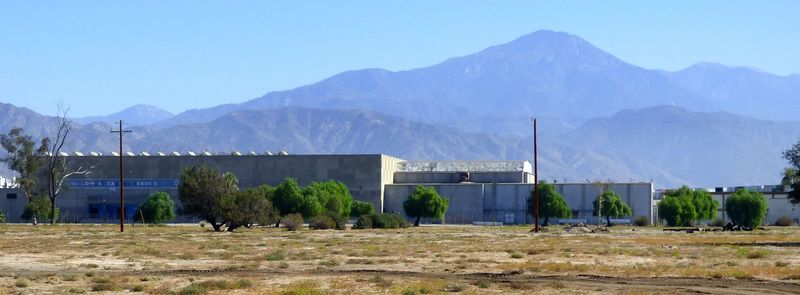Cambria Air Force Station
|
Cambria Air Force Station (1951-1980) - A Cold War Air Force Radar Station first established in 1951 near Cambria, San Luis Obispo County, California. Named Cambria Air Force Station after the location. Initially assigned a Lashup-Permanent ID of LP-2 and then a Permanent ID of P-2, and later a Sage ID of Z-2. Abandoned in 1980. HistoryEstablished in November 1951 with temporary World War II era equipment and became operational in January 1952 as Cambria Air Force Station manned by the 775th AC&W Squadron. The station initially had both a Ground-Control Intercept (GCI) and early warning mission. The early warning mission involved tracking and identifying all aircraft entering their airspace while the GCI mission involved guiding Air Force interceptors to any identified enemy aircraft. Controllers at the station vectored fighter aircraft at the correct course and speed to intercept enemy aircraft using voice commands via ground-to-air radio. The temporary World War II era equipment included a TPS-1C search radar. The follow-on permanent equipment included the FPS-3 search radar and a CPS-4 height-finder radar. The search radar was upgraded to an FPS-7 in 1961 and two FPS-6 height-finders were added in preparation for SAGE operation. SAGE TransitionThe transition of the manual GCI system to the automated SAGE system began with the installation of the FST-2 coordinate data transmitter and search radar upgrades. The FST-2 equipment digitized the radar returns and transmitted the digital returns to the SAGE direction center. Under the SAGE System, interceptor aircraft were directed to their targets by the direction center computers and controllers, greatly reducing the need for local controllers and equipment at every radar station. The FST-2 was a very large digital system using vacuum tube technology. Over 6900 vacuum tubes were used in each FST-2 requiring 21 air-conditioned cabinets, 40 tons of air conditioning, 43.5 kva of prime power, and usually a large new addition to the operations building. The FST-2B modification added two more cabinets but with newer solid-state (transistor) technology to process coded responses from aircraft transponders. SAGE Operation The site began operation as a SAGE site in April 1961 initially feeding the Norton SAGE Direction Center DC-17. In 1963 the FPS-6B height-finder radar was replaced by an FPS-26A. When the Norton SAGE Direction Center DC-17 closed in 1966 control was shifted to Luke SAGE Direction Center DC-21 where it remained until Cambria AFS closed in 1980. The FST-2 was replaced with a more up-to-date coordinate data transmitter, the FYQ-47 by 1977. Gap FillersCambria AFS was responsible for the maintenance of one remote unattended gap-filler radar site. The unattended gap filler sites were placed in locations where the main search radar lacked coverage. These sites were equipped with short range FPS-14 or FPS-18 search radars and FST-1 Coordinate Data transmitters that sent digitized radar target data to a SAGE direction center and to the main radar site. Both the radar set and the FST-1 were dual channel to increase site up time. Maintenance teams were dispatched for regularly scheduled maintenance or when fault indicators on the FSW-1 remote monitoring equipment suggested the site had problems. The FSW-1 also allowed remote operation of specific functions such as channel changes for the radar and for the FST-1, it also allowed remote operation of the diesel generators at the gap filler site. The Cambria AFS gap-filler radar was located at Lockwood, California.
Physical PlantThe physical plant of the site was divided into the main site, a cantonment area, a housing area, and two radio sites. The main site housed the operations buildings, the radar towers, and the backup generators. The cantonment area housed the enlisted barracks, the bachelor officer's quarters, the orderly room, the dining hall, the motor pool, and other support buildings. A small 21 unit housing area for married personnel was located in the town of Cambria. A separate radio site housed the radio equipment for directing aircraft intercepts. Like most early radar stations, Cambria originally had a radio transmitter site and a separate radio receiver site used by local controllers for voice direction of fighter interceptors to their targets. With the SAGE System, the SAGE Direction centers had the primary task of directing intercepts and the local radio sites were reconfigured, usually into a single site that was known as the Ground to Air Transmitter Receiver (GATR) site. The GATR site communicated with the interceptors from either the local site or the SAGE direction center via voice commands and/or a digital data link. ClosureThe inactivation of Cambria AFS was publically announced in April 1978 as a part of a larger plan to cut back on military spending. Cambria AFS and the 775th Radar Squadron were deactivated 30 Sep 1980. Air Force equipment was removed but the infrastructure remained including the radar towers. Both the site and the family housing area were put up for auction and the housing area was sold in January 1983 for $2,601,191.
Current StatusAbandoned by the Air Force. The base was sold on 13 Jan 2005 for two million dollars. The owner is Big Cats LLC, Bernd Schaefers.
See Also:
Sources:
Visited: No
|